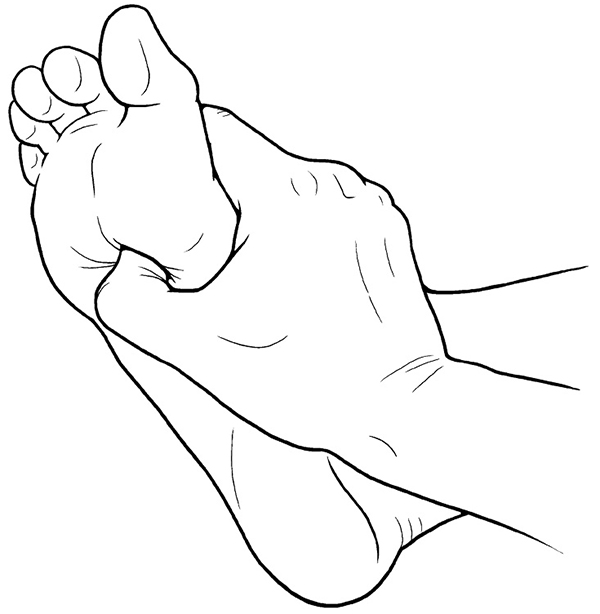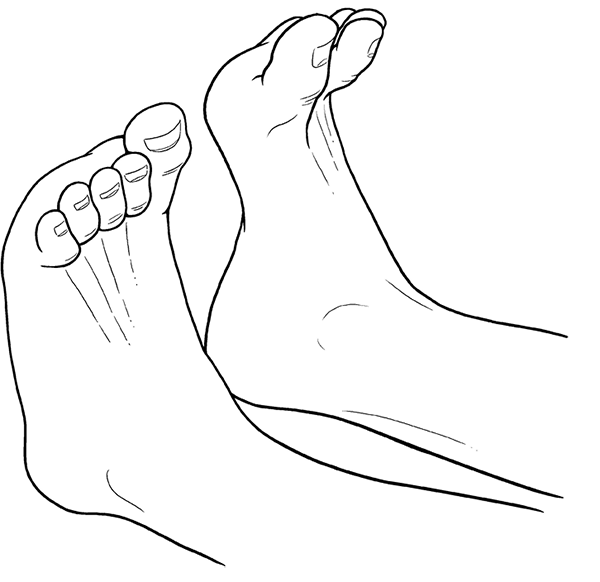Read Chinese Healing Exercises Online
Authors: Steven Cardoza
Tags: #Taiji, #Qi Gong, #Daoist yoga, #Chinese Healing, #Health, #medicine, #remedy, #energy
Chinese Healing Exercises (6 page)
Technique Used
Acupressure

 Figure 1.13A and 1.13B (Pumping the Bubbling Well Point)
Figure 1.13A and 1.13B (Pumping the Bubbling Well Point)
Method
Seated as before with right leg crossed over left knee, place the tip of your right thumb directly on the Bubbling Well point. Maintaining contact with the Bubbling Well point, position your thumb so the thumb tip is perpendicular to the Bubbling Well point
(
Fig 1.13A
),
and the first joint is bent at about 90 degrees. Gently grasp your right foot, the palm and fingers of your right hand on the top surface of your foot, down from your toes and as close to your ankle as is comfortable.
Place your left hand so that the Laogong point contacts the bent joint of your right thumb. Your left thumb points upward and contacts your toes while the fingers of your left hand curl around your upper foot by the margin of your toes, above the fingers of your right hand
(
Fig 1.13B
).
By squeezing your left hand, your left palm will push the tip of your right thumb directly into the Bubbling Well point with more force than you could easily manage with your right thumb alone. Using a pressure that is strong yet comfortable, squeeze your left hand and then release the squeeze rapidly, so that there is a pumping sensation at the Bubbling Well point. Repeat this up to a hundred times, rapidly enough that it would take you no more than a minute.
Ankle Exercises, Seated, Active
The previous exercises have all been passive; that is, you've used your hands to exert an effect on your feet, which have been the passive recipients of the work your hands have done. The next three exercises involve actively using the muscles in your feet and lower legs to mobilize your ankle joints. Regardless of the particular benefits of each exercise, these have the added advantage of drawing more blood into your feet, ankles, and lower legs. Blood always brings nutrition, oxygen, and qi in, and helps remove local toxic accumulations should any be present. It also helps lubricate the joints and muscles. That can help to relax those joints and muscles which may be stiff and achy from relative inactivity, effectively “dried out” from reduced blood flow. Conversely, in other people inactivity will make the blood and other body fluids pool, creating a swelling. The activity of these exercises will help pump out the pooled fluids, and over time will strengthen the muscles so whatever your foot and ankle concerns may be, they will improve and have a reduced likelihood of returning. While the passive exercises may bring some awareness into the body part being worked, the active exercises will deepen your relationship with that part of your body and give you more control over its functions. As a final benefit, many people find these helpful in promoting sleep when practiced just before bed. That's because many types of poor sleep, restlessness, or insomnia are due to too much activity in the mind. Whenever there is activity, there is qi, and too much of that in the brain creates too much thought and mental agitation. The active aspect of these exercises brings the blood down to the feet, and it is the qi that moves and directs the blood, so qi is brought down out of the head. In cases where that is the cause of sleep disturbances, these exercises will remedy the problem.
In each of these ankle exercises, a technique used is a simple daoyin, “guiding and inducing.” They induce the blood to move, and guide it downward toward the feet. Since qi is “the commander of the Blood,” qi is also induced and guided downward, as described in the preceding paragraph.
These exercises are best practiced sitting on the floor, legs extended in front of you, and I will describe them that way. If your legs or back are too inflexible or painful to allow this, you can easily modify these by performing them while sitting in a chair, legs extended as far as is comfortable. Follow all the other instructions as closely as possible.
1. Ankle Flexion and Extension
Purpose
Physical:
Provides linear flexibility in the ankles, improving flexion and extension in the ankles and toes; strengthens and opens the ankle joint and toes; stretches and releases the plantar fascia, the tough membrane covering the sole of the foot.
Energetic:
Stimulates the foot Ying Spring points, found where the toes connect to the foot, and the foot Shu Stream points, found at various places along the circumference of the foot and ankle. Ying Spring points are useful in clearing heat. One of the Western correlations to clearing heat means reducing inflammation, so your toes, as well as other parts of your body along the selected meridian pathways, will benefit from that energetic effect. As discussed earlier, Stream points are most commonly used to treat Bi (pronounced “be”) syndromes, more colloquially called Painful Obstruction syndromes, which are often the same as or associated with various types of arthritis pain. This is especially true if Damp is part of the pathogenic picture, which is almost always the case with Bi syndromes. If Damp is present as swelling or edema, the active motion of the ankle in this exercise is very useful in reducing that swelling, from both physical and energetic standpoints.
Techniques Used
Active stretching, flexion, and extension.
Method
Sitting on the floor with legs extended in front of you, feet six to twelve inches apart, slightly bend your knees, and then “anchor” your heels to that spot on the floor. That is, don't let your heels slide on the floor at all as you move the rest of your foot as directed in each of these exercises. If you keep your heels contacting the floor in one spot only, you'll ensure the fullest possible range of motion when you begin to move your feet. This becomes very easy with a little practice.
Begin with both ankles flexed (dorsiflexed) and toes fully extended, pointing toward your head
(
Fig 1.14A
).
Keeping your toes extended, push the soles of your feet downward (forward), pivoting on your heels, which remain anchored in place (
Fig 1.14B
).
Near the end of your downward push, flex your toes tightly as though you are grabbing something with them
(
Fig 1.14C
).
With your ankles fully extended (plantar flexed) and toes flexed, the sole of your foot should feel “scrunched,” slightly compressed as though it too is attempting to grab something. Keep your toes tightly flexed and pull your foot back by flexing your ankle, still keeping your heel anchored to one spot
(
Fig 1.14D
).
The sole of your foot may feel even more compressed as you do this. As you reach the end of the ankle flexion, open your toes and extend them, once again pointing them toward your head. This brings you to your starting position
(
Fig 1.14A
).
Repeat this ankle flexion and extension 25 times, more if your ankles and feet are healthy.


Figures 1.14A and 1.14B (Ankle Flexion and Extension)


Figures 1.14C and 1.14D (Ankle Flexion and Extension)
 Figure 1.15 (Ankle Flexion and Extension)
Figure 1.15 (Ankle Flexion and Extension)
